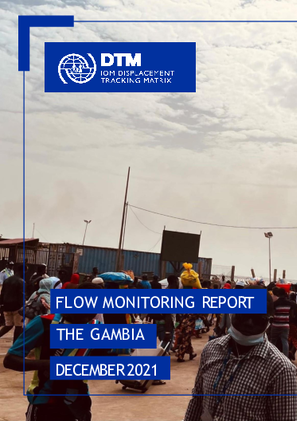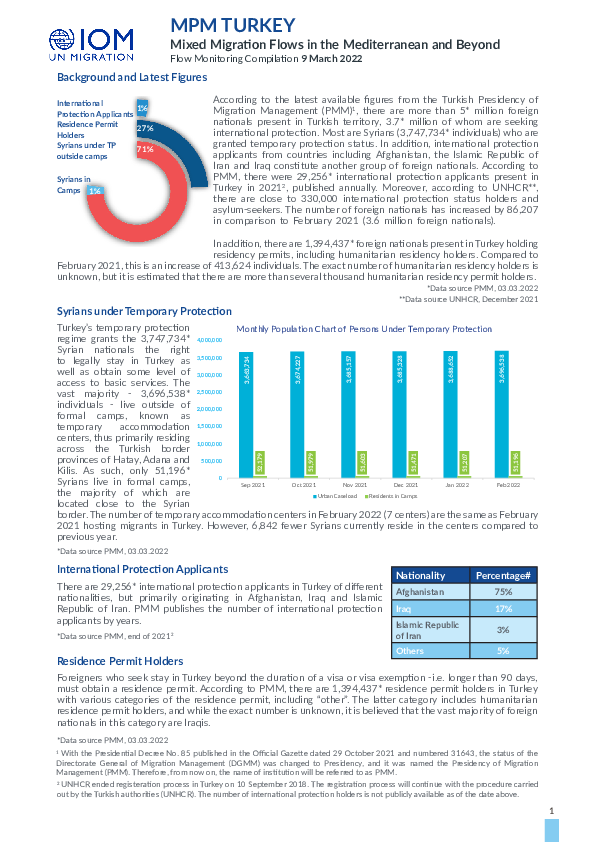-
Countries
-
Data and Analysis
-
Special Focus
-
Crisis Responses

Contact
RO Dakar, RODakar-DataResearch@iom.int
Language
English
Location
The Gambia
Period Covered
Dec 01 2021
Dec 31 2021
Activity
- Survey
- Flow Monitoring Survey
- Flow Monitoring
the Flow Monitoring tool collects data on migration flows and trends, traveller profiles, migration journeys and intentions of migrants in order to obtain a deeper view of mobility in West and Central Africa.
In The Gambia, DTM conducts Flow Monitoring activities at several important transit locations in:
1) Barra (FMPs are located at the ferry terminal and the main garage);
2) Farafenni (FMPs are located at Farafenni main garage, Farafenni Ballan-Ghar garage, Farafenni McCarthy and Sanjally garage, Farafenni turntable garage and the truck garage);
3) Basse (FMPs are situated at the main garage and the bus station in Basse Santa-Su) and
4) Brikama (FMPs are located at the main garage and the Bus station).
These activities enable DTM to monitor the movements of passengers within, out of and towards The Gambia as well as the movements of those passengers transiting The Gambia.
This report presents the key results from the Flow Monitoring Survey conducted from the 1st to the 31st of December 2021.

Contact
DTM Turkey, DTMTurkey@iom.int
Language
English
Location
Republic of Türkiye
Period Covered
Feb 01 2022
Feb 28 2022
Activity
- Flow Monitoring Survey
- Flow Monitoring
- Migrants presence
Mixed Migration Flows in the Mediterranean and Beyond - MPM TURKEY
Flow Monitoring Compilation 9 March 2022
According to the latest available figures from the Turkish Presidency of Migration Management (PMM)1, there are more than 5* million foreign nationals present in Turkish territory, 3.7* million of whom are seeking international protection. Most are Syrians (3,747,734* individuals) who are granted temporary protection status. In addition, international protection applicants from countries including Afghanistan, the Islamic Republic of Iran and Iraq constitute another group of foreign nationals. According to
PMM, there were 29,256* international protection applicants present in Turkey in 20212, published annually. Moreover, according to UNHCR**, there are close to 330,000 international protection status holders and asylum-seekers. The number of foreign nationals has increased by 86,207 in comparison to February 2021 (3.6 million foreign nationals).
In addition, there are 1,394,437* foreign nationals present in Turkey holding residency permits, including humanitarian residency holders. Compared to February 2021, this is an increase of 413,624 individuals. The exact number of humanitarian residency holders is unknown, but it is estimated that there are more than several thousand humanitarian residency permit holders.
*Data source PMM, 03.03.2022
**Data source UNHCR, December 2021
Contact
DTM Libya, DTMLibya@iom.int
Language
English
Location
Libya
Period Covered
Feb 01 2022
Feb 28 2022
Activity
- Site Assessment
- Mobility Tracking
Detention Centre Profiling is a component of IOM Libya’s Displacement Matrix programme. It is a data oriented tool that routinely provides specific sex and age demographic data and key sectorial information on individuals held in Libya’s detention centres on the date of assessment.

Contact
DTM Turkey, dtmturkey@iom.int
Language
English
Location
Republic of Türkiye
Period Covered
Feb 01 2022
Feb 28 2022
Activity
- Flow Monitoring Survey
- Flow Monitoring
- Migrants presence
According to the latest available figures from the Turkish Presidency of Migration Management (PMM)1, there are more than 5* million foreign nationals present in Turkish territory, 3.7* million of whom are seeking international protection.
Most of those seeking international protection are Syrians (3,747,734* individuals) who are granted the temporary protection status in Turkey. In addition, international protection applicants are most frequently nationals of Afghanistan, the Islamic Republic of Iran and Iraq constitute another group of foreign nationals. According to PMM, there were 29,256* international protection applicants present in Turkey in 20212, published annually. Moreover, according to UNHCR**, there are close to 330,000 international protection status holders and asylum-seekers.
In addition, there are 1,394,437* foreign nationals under residence permit holder status; this number includes humanitarian residence holders.
*Data Source PMM, 03.03.2022
**Data source UNHCR, December 2021

Contact
DTM Mauritania, DTMMauritania@iom.int
Language
French
Location
Mauritania
Period Covered
Dec 24 2021
Jan 07 2022
Activity
- Survey
- Migrants presence
- Mobility Tracking
La ville de Rosso, capitale administrative de la wilaya du Trarza est située au sud de la Mauritanie. Du fait de la position frontalière de la ville avec le Sénégal, elle constitue ainsi un point servant de relais entre les deux pays.
Le dynamisme économique, culturel et la position stratégique de la ville de Rosso en font une localité attirant des migrants en provenance de nombreux pays d’Afrique subsaharienne. Rosso est en effet une ville de destination de travailleurs migrants à la recherche d’emploi, tandis que sa position géographique favorise également le transit pour les migrants se dirigeant vers Nouakchott et Nouadhibou mais aussi vers l’Afrique du Nord ou l’Europe.
Ainsi, une meilleure connaissance de la population migrante à Rosso, de leurs profils et besoins permet de mieux concevoir et suivre des programmes visant l’appui de cette population ainsi qu’aux autorités nationales.
C’est dans ce cadre que s’inscrit l’organisation de cette enquête réalisée à Rosso conjointement par l’Agence Nationale de la Statistique et de l’Analyse Démographique et Économique (ANSADE) et l’Organisation Internationale pour les Migrations (OIM). Son but est de mieux comprendre le phénomène migratoire à Rosso (dynamiques, profils ampleur et besoins migratoires) afin de planifier une réponse appropriée comprenant des filières d'orientation appropriées pour les personnes ayant des besoins spécifiques.
Ce présent rapport est consacré aux résultats de l’enquête migration réalisée dans la ville de Rosso du 24 décembre 2021 au 07 janvier 2022.
La région du Sahel central, et plus particulièrement la zone du Liptako Gourma, qui enjambe le Burkina Faso, le Mali et le Niger, est témoin d’une crise complexe qui comprend comme enjeux une compétition grandissante pour le contrôle de ressources; des bouleversements climatiques; une croissance démographique galopante; des niveaux élevés de pauvreté; l’absence d’opportunités économiques et un sentiment de désillusions quant au futur; des tensions communautaires; l’absence de présence étatique et le manque de services sociaux de base; et des violences provoquées par des réseaux de crime organisé et des groups armés non étatiques. La crise a engendré, en 2021, la mort de 5 000 personnes 2020 (au 31 décembre) et conduit à des déplacements de populations significatifs dans les quatre pays touches par la crise. Au 28 fév. 2022, 2 058 769 individus étaient déplacés par la crise, y compris 2 058 769 Personnes déplacées internes (92% de la population affectée) et 185 892 réfugiés (8%). Soixante-et-onze pour cent de la population déplacée (1 604 536 personnes) se trouvaient au Burkina Faso, 16 pour cent au Mali (369 509), 9 pour cent au Niger (197 800) et 3 pour cent en Mauritanie (72 816).

Contact
DTM Nigeria, AllUsersInDTMNigeria@iom.int
Language
English
Location
Nigeria
Period Covered
Mar 02 2022
Mar 02 2022
Activity
- Event Tracking
- Mobility Tracking
On 02 March 2022, a fire outbreak was reported at Muna El Badawy Camp in Jere LGA of Borno State. This is only two weeks since the last incident. The fire damaged and destroyed shelters and belongings of numerous IDP households.
The fire incident fully destroyed 206 temporary shelters, affecting a total of 1,034 individuals in 197 households. The affected individuals included 536 children, 269 women and 229 men.

Contact
DTM Nigeria, AllUsersInDTMNigeria@iom.int
Language
English
Location
Nigeria
Period Covered
Nov 16 2021
Dec 30 2021
Activity
- Mobility Tracking
- Site Assessment
Round 6 of the COVID-19 Situation Analysis is based on the assessment of knowledge, practice and impact of the pandemic on internally displaced persons (IDPs) in conflict-affected communities in the geopolitical zones north-central and north-west Nigeria. Conducted by the Displacement Tracking Matrix (DTM) unit of the International Organization for Migration (IOM), the report covers the period between 16 November and 30 December 2021 and reflects trends from the states Benue, Kaduna, Kano, Katsina, Nasarawa, Plateau, Sokoto and Zamfara.
The first assessment was conducted in July 2020, four months after the first case of COVID-19 was reported in Nigeria. In this report, the results are presented from the 6th round of DTM assessments. The assessments were conducted in 1,654 locations – which is a decrease by 10 locations compared to the 5th round when 1,664 locations were covered. These sites included 97 camps and camp-like settings and 1,557 locations where IDPs were residing among host communities, representing a total of 969,757 IDPs in 157,519 households. The state with the highest number of locations assessed was Katsina State with a total of 297 locations (18%), followed by Kaduna with 262 locations (16%) and Benue with 235 locations (14%). In contrast to Round 5, Zamfara and not Sokoto was the state where the least number of locations were assessed with 126 sites (8%).
As in other similar assessments, staff from IOM, NEMA, SEMAs and the Nigerian Red Cross Society collated the data in the field, including baseline information at Local Government Area and ward-levels.
A total of 95,369 respondents – or 10% of the total IDP population in north-central and north-west Nigeria were interviewed on a range of COVID-19 related indicators. Key informant interviews and focus group discussions were the primary methods used for the assessment and the findings were corroborated with physical on-ground observations.

Contact
DTM Nigeria, AllUsersInDTMNigeria@iom.int
Language
English
Location
Nigeria
Period Covered
Feb 26 2022
Mar 04 2022
Activity
- Mobility Tracking
- Baseline Assessment
- Points of Entry (PoE)
During the COVID-19 pandemic, IOM's Displacement Tracking Matrix (DTM), in collaboration with the World Health Organization (WHO), monitors the movements to and from Nigeria's Adamawa and Borno States in north-east Nigeria. Assessments are conducted at Points of Entry located along the border with Cameroon.
During the period 26 February - 04 March 2022, 344 movements were observed at three Points of Entry in Borno state. Of the total movements recorded, 129 were incoming movements. The incoming movements included 116 persons from the Far North Region in Cameroon, 4 persons from Ndjamena in the republic of Chad, and 9 persons from Bol in the Republic of Chad.
Additionally, a total of 215 outgoing movements were recorded from Borno State towards the Far North Region of Cameroon.
Le rapport de cartographie des mobilites en Afrique de l'Ouest et du Centre presente les tendances de mobilites et facteurs de migration au sein de la region de l'Afrique de l'Ouest et du Centre (deplacements forces, transhumance, migration de main d'oeuvre, etc), soulignant la diversite et la complexite des mobilites dans la region. Le rapport se base sur les donnees recoltees au travers des outils de collecte de donnees de l'OIM et de donnes de partenaires tels que UNDESA, le HCR et les Ministeres de l'interieur.

